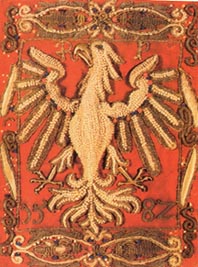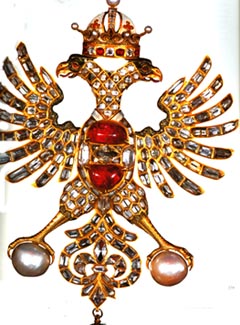
The Significance of the Eagle
Written by Margaret Odrowaz-Sypniewska,
B.F.A.
 The song you hear playing is "Under the Double Eagle" by Josef Franz Wagner
The song you hear playing is "Under the Double Eagle" by Josef Franz Wagner
The U.S. Bald Eagle:

The Bald Eagle is the symbol of the United States of America
In 1782 the United States adopted the Bald Eagle as their national emblem. The eagle appears on U.S. coinage and paper money. The eagle symbolizes strength and power. Normally the bald eagle sits upon an olive branch symbolizing peace. The "double eagle" refers to a US $20 gold piece minted in the 1850's, but it also refers to the famous march, "Under the Double Eagle," written by Josef Franz Wagner. The Wagner piece refers to the double eagle in the coat of arms of the Austro-Hungarian double monarchy. Two eagles can also refer to a pair or to a witness. In the early days of the U.S. government, it had a policy of non-involvement in world affairs. This changed when we were asked to fight in WWI and WWII. Since then our policies have changed drastically.
 ......
......
Left: This ruby Eagle resides with French Crown Jewels.
This piece is known as "The Eagle of Poland."
It was made in Germany between the 16th-18th c. Right: The modified binding of Queen Anna
Jagiellon made by an unknown 16th century
Krakowian artist, done in beadwork and
embroidery.
The Significance of the Eagle:
"The imperial eagle was a battle standard in the time of the earliest Mesopotamian kings and afterwards among the Sumerians; it went into battle with the Roman legions and the troops of Frederick II of Hohenstaufen, just as in the battles of the First World War it accompanied the armies of His Apostolic Majesty the Emperor of Austria and the Tsar of All the Russias. The double eagle, officially incorporated into the arms of the Empire in the fifteenth century in the reign of Sigismund, is first found in Mesopotamia" Herr, 3).

This eagle brooch-pendant is from the Bavarian Crown
Jewels Collection. It belonged to the Dutchess Anna,
daughter of Emperor Ferdinand I. Anna
was also the wife of Duke Albrecht V. This
beautiful diamond and ruby jewelry was made in
the mid 16th century.
The Eagle is known to many as "the KING of Birds."
The eagle was one of the earliest heraldic charges. It symbolized royal power, courage, and magnanimity. The eagle is associated with the Holy Roman Empire. It is borne by many ruling houses and royal arms of Germany, Russia, Austria, Prussia, Saxony, Lorraine, Leingen, and Poland.
The Eagle was said to be able to gaze directly into the sun without blinking; and traverse regions of the heavens to which humans had no access.
In Babylonian records it states that King Etana was borne into the heavens by an eagle. Many old royal funeral customs involved the releasing of an eagle at the funeral of the ruler. The eagle was released as the body was being cremated to symbolize the souls descent from the body to the heavens.
In ancient Syria the eagle was a sun-god. It was thought of much like the legends of the Phoenix. The eagle also represented baptism. This most likely is because the eagle kills snakes and dragons (a winged serpent). This symbolic of the serpert (as satan) and the truimph of good (the eagle) over evil. An eagle with a snake in its mouth is part of the symbol of Mexico and it can be seen on their flag.
Thus the eagle is thought to be the symbol of John, the baptist.
In Freemasonry, the double eagle is a symbol of the 33rd degree of the Scottish Rite, with a crown upon its two heads. A sword is then held horizontally in its claws. Their motto: Deus meumque ius - "God and my right."
The Quauhtli (eagle) is the 15th of the 20 days of the Aztec calendar. Two elite warrior classes within Aztec society were the Eagle and the Jaguars warriors. The eagle stood for the heavens, and the Jaguar for the earth. Aztec goddess, Cihuacoatl (snake woman) has another side called Quauh-Cihuatl (eagle woman). She is depicted wearing a crown of eagle feathers and was thought to be the leader of all women who died in childbirth. In Aztec society giving birth was an extremely important act of military heroism. Women gave birth to soldiers.
In Iroquoian legends, Degananwidah, the Man From the North, envisioned an eagle above the Great Tree of Peace. The eagle's far-seeing eyes would be alert to the slightest danger to the tree's roots, and thus to peace. The Great Tree is often depicted with an eagle atop.
In ancient China, "ying" is the word for eagle and hero.
In Hindu mythology, the bird called Garuda was the eagle that fought the snake.
The Persians used the eagle as a military standard in the 5th century B.C., the Egyptians used the eagle at a very early date, and the Romans used it in the second century B.C. Byzantium used the eagle as its symbol in 328, and the doubled-headed eagle stood for the Eastern and Western Empires, with Russia using the eagle in the 15th century A.D.
The eagle and lion are used for European coats of arms in a stylized form.
The Holy Roman Empire, beginning with Charlemagne, as their leader, adopted the single-headed eagle, as his claim as successor to the Roman Caesars. Germany and Austria used the double-headed eagle from the Emperors of the Holy Roman Empire. Poland used the white eagle. (Norris)
The Order of the White Eagle is thought to be as old as the time of Lech I, Prince of Poland (6th century), but for certain it was founded by Casimir of the Piast Dynasty, who married Anna, Princess of Lithuania.
The Minnesinger Reinmar used in his insignia, a three-headed eagle with additional heads on the tips of its wings. A,G, Böckler in 1688 wrote:
The eagle is the king among feathered beasts. His stern gaze can regard the sun; he always gets his prey; he rejuvenates himself; he flies highest; and his passing overhead is a universal augur of victories to come. And because Romulus on the Aventine Hill was the first to see an eagle, he took it as a good omen, and had an eagle rather than a flag borne before his army. There are six kinds of eagles, all of them birds of prey, but only the smallest and most inferior of them will attack a carcass. The eagle is not the personal symbol of the emperor but rather the Holy Roman Empire. The eagle on a field of gold refers to God the Father, whose star shines bright, bringer of serenity, inspirer of awe.
EAGLE FLAGS:

*****
SOURCES:
Biedermann, Hans. Dictionary of Symbolism: Cultural Icons & Meanings Behind Them. New York: A Meridian Book, 1994.
Guadalupi, Gianni. The World's Great Treasures. New York: Stewart, Tabori, and Chang, 1998.
Herr, Friedrich. The Holy Roman Empire. London: Phoenix Press Paperback, 1968.
Norris, Herbert, Medieval Costume and Fashion. New York: Dover Publications, Inc., 1999

The Odrowaz Arms
You are the  visitor since July 31, 2003
visitor since July 31, 2003
Home
Last updated on June 11, 2006
© 1997 E-Mail:Vondoering@aol.com
This page is hosted by